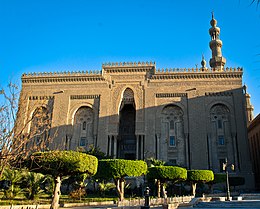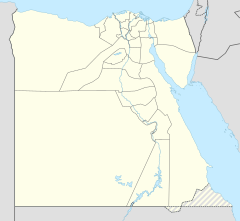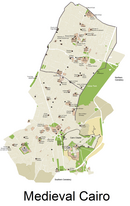| Revision as of 11:01, 11 November 2023 editBoredom889 (talk | contribs)Extended confirmed users572 edits Removed unsourced info, added new informationTags: nowiki added Visual edit Mobile edit Mobile web edit← Previous edit | Revision as of 11:14, 11 November 2023 edit undoBoredom889 (talk | contribs)Extended confirmed users572 edits Completely revamped the style section and removed unsourced informationTags: Mobile edit Mobile web editNext edit → | ||
| Line 47: | Line 47: | ||
| ==Style== | ==Style== | ||
| When developing its design, the architects of Al-Rifai Mosque tried to match the Sultan Hassan Mosque next to it in grandeur and height<ref>Abdulwahhab, Hassan (1946). تاريخ المساجد الأثرية (1946 edition ed) volume 1</ref> even though they faced some difficulties that were criticized by archaeologists and which was remedied under the supervision of Max Herz.<ref>Abdulwahhab, Hassan (1946). تاريخ المساجد الأثرية (1946 edition ed) volume 1</ref> | |||
| The building itself is a melange of styles taken primarily from the ] period of ], including its ] and ], and ]ian style pillars. The building contains a large prayer hall as well as the shrines of ] and two other local saints, Ali Abi-Shubbak and Yahya al-Ansari. Because of the time taken to build the mosque, it represents historical and political revolution in Egypt. The entrance is lined with marble columns. | |||
| The interior area of the mosque is 6,500 square metres, the part designated for prayer is 1,767 square metres, and the rest of the space is allocated for the zawiya shrine and the royal mausoleum. The mosque has two minarets built on circular bases, like the minarets of the Sultan Hassan Mosque. As for the entrances, they are towering and surrounded by stone and marble columns with Arabic capitals. Their lintels are decorated with marble, and their tops also covered with polished and gilded arches.<ref>Abdulwahhab, Hassan (1946). تاريخ المساجد الأثرية (1946 edition ed) volume 1</ref> | |||
| In the middle of the western side is the entrance to the royal mausoleum, which is surrounded by stone columns with ornate marble bases. To the right of the interior of this door is the tomb of ] in the western front corner of the mosque. It is covered with colored marble, and adjacent to it is the tomb of his mother, ]. At the end of the room, there is a door, which leads to another room that contains the tomb of Sheikh Ali Abu Shubbak Al-Rifa'i. This room is topped by a dome. The grave is covered by a wooden ] built around it. Between the two front doors is a smaller entrance leading to a room which holds the grave of Yahya Al-Ansari.<ref>Abdulwahhab, Hassan (1946). تاريخ المساجد الأثرية (1946 edition ed) volume 1</ref> | |||
| ] the last ] is buried there, thanks to the ] ]]] | ] the last ] is buried there, thanks to the ] ]]] | ||
Revision as of 11:14, 11 November 2023
Mosque in Egypt| This article needs additional citations for verification. Please help improve this article by adding citations to reliable sources. Unsourced material may be challenged and removed. Find sources: "Al-Rifa'i Mosque" – news · newspapers · books · scholar · JSTOR (December 2020) (Learn how and when to remove this message) |
| Al-Rifa'i Mosque | |
|---|---|
 The northern facade of the mosque, with the original royal entrance. The northern facade of the mosque, with the original royal entrance. | |
| Religion | |
| Affiliation | Sunni Islam |
| Location | |
| Location | Cairo, Egypt |
 | |
| Geographic coordinates | 30°9′16.43″N 31°18′37.46″E / 30.1545639°N 31.3104056°E / 30.1545639; 31.3104056 |
| Architecture | |
| Architect(s) | Max Herz |
| Type | mosque |
| Style | Islamic architecture, Ancient Egyptian |
| Completed | 1912 |
| Capacity | 10,000 |
Al-Rifa'i Mosque (Template:Lang-ar, transliterated also as Al-Rifai, Al-Refai, Al-Refa'i, locally known as El-Refa'i, and in English: the Refaai Mosque) is located in Citadel Square, adjacent to the Cairo Citadel. Now, it is also the royal mausoleum of Muhammad Ali's family. The building is located opposite the Mosque-Madrassa of Sultan Hassan, which dates from around 1361, and was architecturally conceived as a complement to the older structure. This was part of a vast campaign by the 19th century rulers of Egypt to both associate themselves with the perceived glory of earlier periods in Egypt's Islamic history and modernize the city. The mosque was constructed next to two large public squares and off of several European style boulevards constructed around the same time.
History
The original structure on the site was a small 12th century Fatimid-era mosque, known as the Al-Dakhirah Mosque. But later, the grandson of Ahmad al-Rifa'i, Ali Abu Shubbak al-Rifa'i, was buried within it, and the place was converted into a Zawiya for the Rifa'i tariqah. This Zawiya became known as the Al-Bayda Zawiya, and it not only contained the tomb of Ali Abu Shubbak, but also included the tomb of another Sufi mystic, Yahya al-Ansari.
The present structure of the Al-Rifa'i Mosque was constructed in two phases over the period between 1869 and 1912 when it was finally completed. It was originally commissioned for Hoshiyar Qadin, the mother of the 19th century Khedive Isma'il Pasha to expand and replace the old Zawiya. Hoshiyar ordered an extensive renovation of the zawiya, and so the original structure save for the graves of Ali Abu Shubbak and Yahya al-Ansari was demolished. The new structure was also intended to contain the burial place of the Khedive family.
The original architect was Hussein Fahri Pasha, a distant cousin in the dynasty founded by Muhammad Ali of Egypt in 1803, but he died during the first phase of construction, and work was halted after the abdication of Khedive Isma'il Pasha in 1880. Hoshiyar Qadin herself died in 1885, and work was not resumed until 1905 when the new Khedive, Abbas II of Egypt, ordered its completion. Construction work was supervised by the Hungarian architect Max Herz, head of the Committee for the Conservation of the Monuments of Cairo.
Style
When developing its design, the architects of Al-Rifai Mosque tried to match the Sultan Hassan Mosque next to it in grandeur and height even though they faced some difficulties that were criticized by archaeologists and which was remedied under the supervision of Max Herz.
The interior area of the mosque is 6,500 square metres, the part designated for prayer is 1,767 square metres, and the rest of the space is allocated for the zawiya shrine and the royal mausoleum. The mosque has two minarets built on circular bases, like the minarets of the Sultan Hassan Mosque. As for the entrances, they are towering and surrounded by stone and marble columns with Arabic capitals. Their lintels are decorated with marble, and their tops also covered with polished and gilded arches.
In the middle of the western side is the entrance to the royal mausoleum, which is surrounded by stone columns with ornate marble bases. To the right of the interior of this door is the tomb of Fuad I of Egypt in the western front corner of the mosque. It is covered with colored marble, and adjacent to it is the tomb of his mother, Ferial Qadin. At the end of the room, there is a door, which leads to another room that contains the tomb of Sheikh Ali Abu Shubbak Al-Rifa'i. This room is topped by a dome. The grave is covered by a wooden zarih built around it. Between the two front doors is a smaller entrance leading to a room which holds the grave of Yahya Al-Ansari.

Usage
The mosque is the resting place of Hoshiyar Qadin and her son Isma'il Pasha, as well as other members of Egypt's royal family, including Sultan Hussein Kamel, Sultan and King Fuad I, and King Farouk, whose body was interred here after his death in Rome in 1965. Khedive Tewfik and Khedive Abbas II Hilmi, however, are buried in Qubbat Afandina, a mausoleum built in 1894 in Cairo's Eastern Cemetery, together with other late members of the Muhammad Ali Dynasty.
The mosque served briefly as the resting place of Reza Shah of Iran, who died in exile in the Union of South Africa in 1944, and was returned to Iran after World War II. Part of the burial chamber is also occupied by Reza Shah's son Mohammad Reza Pahlavi, who died in Cairo in July 1980. He was buried in Cairo following the Iranian Revolution of 1979.
See also
- Muhammad Ali Dynasty family tree
- Al-Nasir Muhammad Mosque, royal mosque of the Mamluk Sultanate founded in 1318 in the Citadel of Cairo by the Sultan an-Nasir Muhammad.
- Timeline of Islamic history
- Islamic architecture
- Islamic art
- Lists of mosques
- List of mosques in Africa
- List of mosques in Egypt
- List of mausolea
References
- ^ Samir, Salwa (4 October 2012). "Meeting a royal family at Al-Rifa'i". The Egyptian Gazette. Retrieved 16 July 2013.
- https://egymonuments.gov.eg/monuments/al-rifa-i-mosque/
- Encyclopedia of Egypt’s Mosques and their Righteous Saints, by Suʻād Māhir Muḥammad
- https://egymonuments.gov.eg/monuments/al-rifa-i-mosque/
- Abdulwahhab, Hassan (1946). تاريخ المساجد الأثرية (1946 edition ed) volume 2
- Encyclopedia of Egypt’s Mosques and their Righteous Saints, by Suʻād Māhir Muḥammad
- Encyclopedia of Egypt’s Mosques and their Righteous Saints, by Suʻād Māhir Muḥammad
- Abdulwahhab, Hassan (1946). تاريخ المساجد الأثرية (1946 edition ed) volume 1
- Abdulwahhab, Hassan (1946). تاريخ المساجد الأثرية (1946 edition ed) volume 1
- Abdulwahhab, Hassan (1946). تاريخ المساجد الأثرية (1946 edition ed) volume 1
- Abdulwahhab, Hassan (1946). تاريخ المساجد الأثرية (1946 edition ed) volume 1
- Historical Iranian Sites and People. 12 December 2010
Further reading
- al-Asad, Mohammad. The Mosque of Rifa'i in Cairo. 1993. In Muqarnas X: An Annual on Islamic Art and Architecture. Margaret B. Sevcenko (ed.). Leiden: E.J. Brill.
- Jones, Dalu. "Va Pensiero... Italian Architects in Egypt at the Time of the Khedive.” In Environmental Design: Journal of the Islamic Environmental Design Research Centre, 86–93. Rome: Carucci Editore, 1990.
- Arnaud, Jean-Luc. "Maps of Cairo and the Development of the City at the End of the 19th Century.” In Environmental Design: Journal of the Islamic Environmental Design Research Centre 1–2, edited by Attilo Petruccioli, 82–91. Rome: Dell’oca Editore, 1993.
- Noweir, Sawsan and Philippe Panerai. "Cairo: The Old Town.” In Environmental Design: Journal of the Islamic Environmental Design Research Centre 1–2, edited by Attilo Petruccioli, 60–67. Rome: Carucci Editore, 1989.
External links
- Al-Rifa'i Mosque
- The Royal Mosque - Al Rifai (Archived 24 October 2009)
